
This electronic edition published in 2015 by Bloomsbury Publishing Plc
First published in Great Britain in 2014 by Osprey Publishing Ltd.
2015 Osprey Publishing Ltd. and Warlord Games
Osprey Publishing
PO Box 883, Oxford, OX1 9PL, UK
PO Box 3985, New York, NY 101853985, USA
E-mail:
Bloomsbury is a trademark of Bloomsbury Publishing Plc
Osprey Publishing is part of the Osprey Group
Warlord Games
T13/T15, The Technology Wing, The Howitt Building, Lenton Business Centre, Lenton Boulevard,
Nottingham, NG7 2BD, UK
E-mail:
All rights reserved
You may not copy, distribute, transmit, reproduce or otherwise make available this publication (or any part of it) in any form, or by any means (including without limitation electronic, digital, optical, mechanical, photocopying, printing, recording or otherwise), without the prior written permission of the publisher. Any person who does any unauthorised act in relation to this publication may be liable to criminal prosecution and civil claims for damages.
A CIP catalogue record for this book is available from the British Library
Print ISBN: 978-1-4728-0741-0
PDF e book ISBN: 978-1-4728-1362-6
EPUB e book ISBN: 978-1-4728-1363-3
Osprey Publishing is supporting the Woodland Trust, the UK's leading woodland conservation charity, by funding the dedication of trees.
www.ospreypublishing.com
For more information on Bolt Action and other products, please visit www.warlordgames.com
To find out more about our authors and books visit www.bloomsbury.com. Here you will find extracts, author interviews, details of forthcoming events and the option to sign up for our newsletters.
CONTENTS

Senegalese Tirailleurs section

EARLY WAR IN EUROPE
T his book is a supplement for the Bolt Action World War II tabletop wargame. It contains all the background, rules and Theatre Selector information to field armies from the Blitzkrieg era in the Western European Theatre, which for our purposes includes Poland but not Russia, from 1939 to 1940. The Eastern and Mediterranean campaigns will be covered elsewhere.
 This is not a narrative history. Historical points are only discussed where their interpretation has some direct bearing on the wargame rules or to establish context. You will require the Bolt Action rulebook to use this supplement. You will also find the relevant Bolt Action national army supplements useful but not absolutely essential since the information within them can be recreated using the selectors in the core rule book as guides. These supplements include Armies of Great Britain, Armies of Germany, Armies of France and the Allies, Armies of Italy and the Axis and Tank War.
This is not a narrative history. Historical points are only discussed where their interpretation has some direct bearing on the wargame rules or to establish context. You will require the Bolt Action rulebook to use this supplement. You will also find the relevant Bolt Action national army supplements useful but not absolutely essential since the information within them can be recreated using the selectors in the core rule book as guides. These supplements include Armies of Great Britain, Armies of Germany, Armies of France and the Allies, Armies of Italy and the Axis and Tank War.
German Strikes! is subdivided into four main sections/campaigns: Fall Weiss (Poland), Weserbung (Denmark & Norway), Fall Gelb (The Low Countries), and Fall Rot (France).
This era is one of the most fascinating periods to wargame because new technology dramatically changed the art of war. National armies in the 1930s struggled to develop weapons and doctrines to incorporate rapid technological advance. Different nations had different ideas so these campaigns saw not just a clash of armies but also a clash of concepts. Undoubtedly German doctrine prevailed, so their version of mechanised warfare has given its name to the whole period: Blitzkrieg.

Panzers Marsch! The armoured column heads into enemy territory

STATIC WARFARE
The late 1930s and opening years of World War II are synonymous with the developing concept of Blitzkrieg and mechanised warfare. The use of specialised machines in combat is as old as organised warfare itself, as attested by the squadrons of chariots used by the great palace civilisations of the Bronze Age.
The art of mass industrial killing reached its apogee in World War I. Soldiers in the combat zone moved at the same speed as Wellingtons or Caesars troops but the killing range and power of missile weaponry had substantially increased. Indeed, one can make a good case that mobility was at its perigee because horses were swept from the battlefield by machine guns and explosive shells.
Breakthroughs had become near impossible because the defender had all the advantages. These not only included the tactical advantage of the lethality of firepower, but also operational advantages as the defender could use railways and wheeled vehicles to concentrate supplies and reinforcements at threatened points. Meanwhile the attackers ability to exploit any penetration of the line was limited to the speed of men on foot moving through shell holes and barbed wire.
The only support weapons and logistics available to the attacking infantry once they had left the protection of the preprogrammed preliminary bombardment was what they could carry with them. Men staggered forward under the burden of up to 18 kilos (about 40 pounds) of equipment, but it could never be enough to overwhelm defenders sitting on top of stockpiled ammunition and heavy weapons.
Furthermore the defender could maintain a degree of command control by using buried telephone lines. For the attacking troops, however, once they went over the top control was limited to the range an individual could see (and shout). So the defender always had the advantage of a faster OODA Loop: the speed with which an army command can Observe, Orient, Decide and Act.
By the end of World War I the glimmers of a new type of warfare were visible. Tracked all-terrain armoured vehicles supported by aircraft acting as flying artillery and command control by radio offered the possibility of restoring mobility to the battlefield. Military theoreticians and far-sighted soldiers floated new concepts described by a new military terminology: phrases such as decisive battle, indirect approach, deep thrust, defence in depth and finally, Blitzkrieg.
The new warfare depended on novel machines in new organisations, but what form these would take was a matter of fierce debate. To some degree doctrine and technology were intertwined. Doctrine was developed to exploit new technical possibilities, but exactly what was built depended on what armies proposed to achieve and what their sponsoring taxpayers could afford.
In the early years everyone was still feeling their way. A rich profusion of flawed, inadequate and unreliable machinery saddled the poor benighted soldiery. In the heat of battle, evolution was fast and only the fittest survived to provide the templates for the mechanised divisions that defined warfare over the next century.

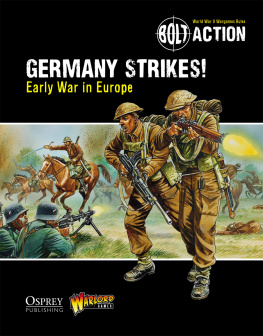
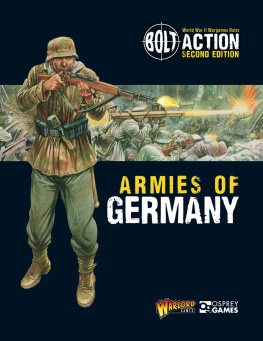
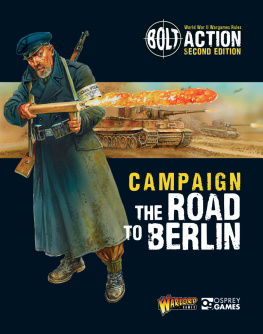
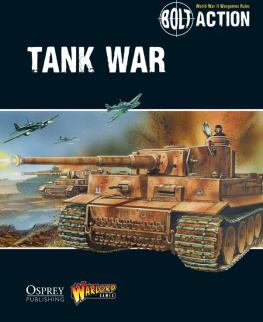
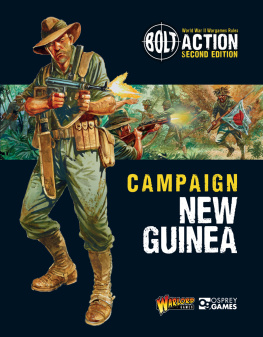
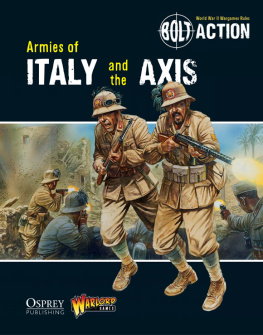
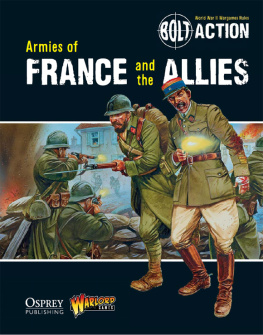

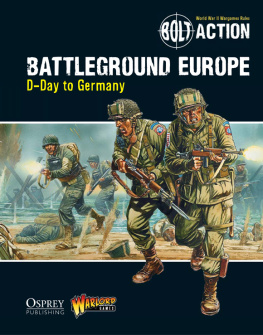

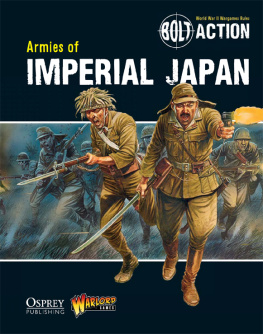
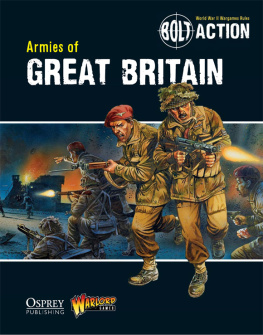
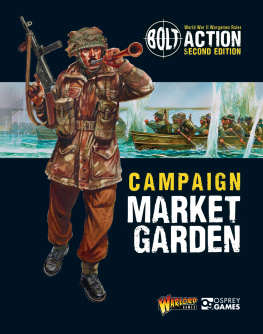
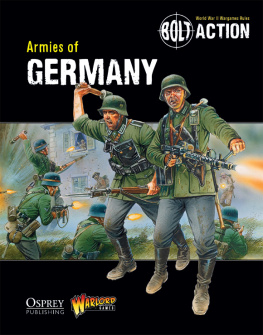
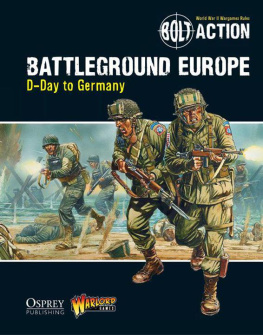




 This is not a narrative history. Historical points are only discussed where their interpretation has some direct bearing on the wargame rules or to establish context. You will require the Bolt Action rulebook to use this supplement. You will also find the relevant Bolt Action national army supplements useful but not absolutely essential since the information within them can be recreated using the selectors in the core rule book as guides. These supplements include Armies of Great Britain, Armies of Germany, Armies of France and the Allies, Armies of Italy and the Axis and Tank War.
This is not a narrative history. Historical points are only discussed where their interpretation has some direct bearing on the wargame rules or to establish context. You will require the Bolt Action rulebook to use this supplement. You will also find the relevant Bolt Action national army supplements useful but not absolutely essential since the information within them can be recreated using the selectors in the core rule book as guides. These supplements include Armies of Great Britain, Armies of Germany, Armies of France and the Allies, Armies of Italy and the Axis and Tank War.
